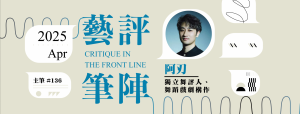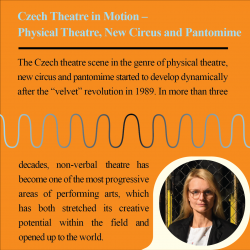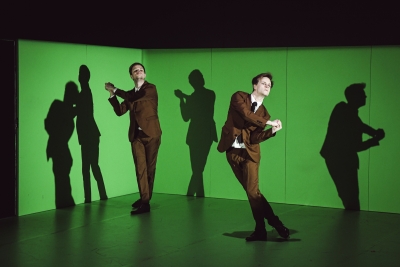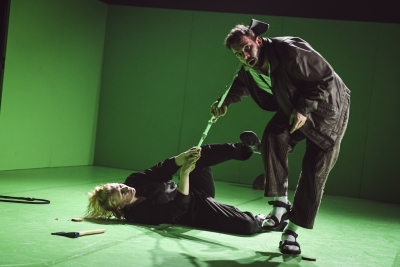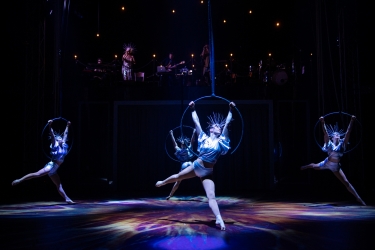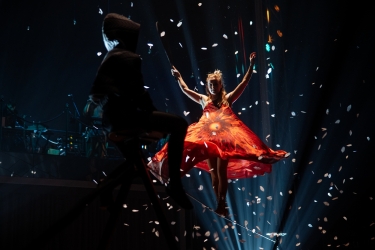2024年7月
The Czech theatre scene in the genre of physical theatre, new circus and pantomime started to develop dynamically after the “velvet” revolution in 1989. In more than three decades, non-verbal theatre has become one of the most progressive areas of performing arts, which has both stretched its creative potential within the field and opened up to the world. Just after the turn of the millennium, the ensemble Farm in the Cave, led by founder and director Viliam Dočolomanský, began its activities, characterised by a strong interplay of music and body, musicality and physicality – the Immerse Performing technique. In his creative research in the genre of physical theatre, he has long applied the methods of ethnography and anthropology, and nowadays he is leaning towards social engagement. In the field of new circus in the Czech Republic, before the end of the first decade (2009), under the leadership of brothers Rostislav Novák Jr. and Vít Novák, a group of enthusiasts united within the multidisciplinary project La Putyka and thus the largest domestic new circus company Cirk La Putyka was founded. Its significance lies in its enormous commitment, the breadth of its activities, including pro-social ones, and its artistic-experimental projects alongside the popular ones. The third important aspect of Czech movement theatre is pantomime. Its most prominent representative is mime Radim Vizváry. He followed the grammarians and artists of “quietly poetic” art as Étienne Decroux, Marcel Marceau, Boris Hybner, and by combining the techniques of mime corporeal, butoh and physical theatre he created his own concept called physical mime.
The situation will be outlined in more detail by the reflection of three important premiers over the last season.
Who is the Czech hero?
Czech Hero by Farm in the Cave (Photo: Michal Hancovsky)
A political satire or figuratively fragmented tragicomedy called Czech Hero communicated a thematic triptych: disinformation – manipulation – radicalisation. From visually compelling fragments, the authorial team assembled a scenic portfolio of supposed heroism that emerges as a bizarre outcome of rhetorically suggestive campaigns often, but not exclusively, linked to political marketing. The case of the “first Czech terrorist” is a completely significant example from the recent past and the mainstay of the production. Seven years ago, he placed felled trees on a railway line, twice. Fortunately, the threat to persons and property was diverted, and the “hero” with a morbid fear of the arrival of Islamists was arrested and sentenced to prison and psychiatric treatment. However, this seemingly grotesque situation, the main character of which was a rural pensioner with the features of a geeky activist against the Islamisation of domestic culture, who, among other things, wanted to draw media attention to himself, revealed a much more insidious background, such as the disinformation websites and the associated systematic subliminal exhortations “to change – to act”.
The author of the concept and the director Viliam Dočolomanský has thus set out in this creative struggle into another socially-engaged ring tied to radicalisation. While his previous work Commander, premiered in 2022, explored the environment of cyberspace in detail and focused primarily on children and youth, in the Czech Hero performance the director targeted the elderly, the countryside and publicly shared space. He has chosen the means of an austere physical expression, even a kind of distilled physical theatre with elements of dance and drama, whose equal partner – traditionally – is live music. The minimalist set of props was framed by a greenish set, evoking a television news studio but also a gardener’s obsession with neatly trimmed greenery. The interplay of all the staging components exhibited a distinct rhythmically refined structure.
The five performers sketched the present as a period no longer reacting slowly to differences of opinion, but rather as a period of suddenly opposing anything to which it is possible to find a contradictory attitude. In Czech Hero, the play with tension, who was with whom, flowed on a wave of irony and cruelty, the heated alternating with the creeping, the punchy overcoming the comic. Right from the start, dancer Andrej Štepita’s choreography made its way onto the imaginary list of Farm in the Cave’s unforgettable movement scores, which include the women’s choral choreography from SCLAVI / The Song of an Emigrant (2005) and Jun-Wan Kim’s solo from The Theatre (2010). Štepita’s “tap dancing” solo with a French stick managed to say everything that was relevant in the given space-time within the opening few minutes. The impression of simplicity was increasingly shown to be false as the character gradually revealed his hidden abilities and skills; the implied disability depicted by the compensatory aid paradoxically expanded the possibilities of the human body. In his etude, the dancer in realistic costume, including sandals with white socks, which can be seen as a symbol of tastelessness, or perhaps of comfort or principled opinion, foreshadowed the unpredictability of all that followed, and in terms of the whole, brought out the key repetitive motif of urgency, of demagogic zeal. The atmosphere of the performance was completed by the performer Hana Varadzinová as a journalist and the dancers Michaela Králiková, Matúš Szegho and David Králík, who met, passed each other and collaborated on stage in different roles. They evoked members of the national political representation, easily influenced inhabitants of the Czech countryside, eternal complainers about the situation, anonymous commentators from internet discussions and certainly many others.
Czech Hero by Farm in the Cave (Photo: Michal Hancovsky)
On a physical level, and not only during the aforementioned prologue with the French crutch, it was evident that Farm in the Cave works with a mastered movement keyboard. There were vigorous gestures executed with controlled intensity or precise phrasing and rhythmization, balancing, forcefully broken cuts, conscious stepping or, on the contrary, playing with wobble. The observed vocabulary used included principles of movement progression based on grounding, working with the centre of gravity, the interplay of different rhythms and tensions in the body, and the non-contact sharing of tension between performers. The precise physical articulation, the overall mobilization and collective connection, whether in asynchronous arrangement or, conversely, in accentuated unison, was evident, quite common for Farm in the Cave. The company’s founder had been developing this technique since his first stage research – a theatrical expedition carried out in 2001 as part of the project Sonnets of Dark Love – and only later named it Immerse Performing.
The production of Czech Hero can be metaphorically perceived as an invitation to a common banquet, where fragments of today are laid out as a kind of situational snippets including samples of atypical behaviour or manifestations of heroes, whether they are strange “with good intentions to protect” the Czech Republic and the world, or seeing and knowing, with the aim of revealing or at least understanding without judgment, the motivations of the former. It is a highly aestheticized platform built on an intellectually non-linear dramaturgy, and it also attracts attention thanks to the virtuoso performances of the performers.
15 years in one blink of an eye
Cirk La Putyka celebrated its 15th anniversary in 2024, creating an 80-minute show for 35 performers from three generations. With a spectacular program called Okamžik (Eye-Blink), the creators and an international line-up of performers paid tribute to the perseverance, diligence and cohesion of the circus community. The production was directed by Maksim Komaro, for whom the production was the 7th title resulting from a 13-year collaboration. The composition, rich in a variety of artistic disciplines, was based on a series of pointed numbers and tricks, as well as theatrical situations linked to the founders’ ancestral puppetry and circus tradition. The whole was characterized by a visually impressive environment, an atmosphere imbued with energy and adrenaline. With each step into a new situation, there were reasons to celebrate both birthdays and the non-competitive possibilities of the human body in an unusual scenic combination.
Cirk La Putyka has long held a privileged position in the context of the Czech new circus scene thanks to the artistic range and diversity of its cultural activities. Variety is essential, contrasting theatrical mash-ups with deep emotional investment, and acknowledged play with likability or the globally superficial, without the team giving up originality. Also determining are the theatrical situations set in an environment full of paradoxes and the juxtaposition of seemingly incompatible levels, for example in the relationship between theme and stylized costume or specific music and a certain discipline. Figuratively, then, what is seen does not appear as a harmonic scale, but as a functional dissonance against a background of sur-reality, hence a reality constructed not causally and factually, but as a crossroads of challenges finding contact surfaces in feelings and intuition, eye-catching action or innovative interplay through an atypical combination of physical prowess and circus skills.
The layering or overlapping of planes with an emphasis on visual-physical experience seems to be more typical of the principal Rostislav Novák Jr., while linearity in the sense of a chain of numbers, sensory perception superior to rational perception, and an ascending level of risk are more typical of the guest Finnish director Maksim Komaro. As a director, Rostislav Novák Jr. has signed legendary titles such as the still performed La Putyka (2009) or the first production with a fully international cast, The Dolls (2014), the project reflecting the gender roots of Family (2015) or the Czech-Ukrainian production Boom (2022). He has always paid attention to the uniqueness of thematic reflection, format and artistic treatment. He then closed the first decade of the company with the programme Roads (2021) in the style of “the best of” and, in terms of dramaturgy, introduced Cirk La Putyka into the wider romanticizing context of family circuses. Maksim Komaro, the director of Slapstick Sonata (2012), Play (2014), Batacchio (2017), Isole (2019), Kaleidoscope (2020) and Senses (2022), focused in the Okamžik primarily on celebration in the sense of the desire to enjoy every step together “here and now” and to make the most of everything lived so far in every eye-blink. However, he always turned to the history of the ensemble only for a moment, just as if he were looking into a family photo album. The plane of memories was mainly covered by the Novák parents with puppets and objects that came to life in their hands. The cabaret format exhibited wealth in terms of human and creative capital.
The festive performance ritualistically confirmed the past 15 years and at the same time sent a clear message that the internationally active Czech company Cirk La Putyka is in full force and heading into the next projects and seasons with a creative flourish. If the principal Rostislav Novák Jr. made it clear once again and significantly that the success of the ensemble is based primarily on relationships and reliance on each other, director Maksim Komaro has figuratively turned these starting points into cotton balls on an embroidery canvas and together they have woven a tapestry that can attract the widest public without reserve. Cirque La Putyka’s anniversary of discovery and remembrance, captivation and cradling, burning with fervor and smoldering, cannot be denied its fascinating enthusiasm, its belonging, its ability to reach out and to sweep you away with its energy. The circus is a risk with everything and every moment can start a change or leave an imprint.
Mime on the Moon
Mimi on the Moon by Radim Vizváry (Photo: Anna Solcova)
Czech mime Radim Vizváry entered the broadest audience awareness in 2016, when he won the prestigious Thalia Award for his work Solo. He is a type of Pierrot of the Romantic period of mime in appearance, and a versatile performer in general, for whom the syncretism of the roots of traditional lyrical mime and physical theatre is a fertile ground for his own contemporary work. In his production of Mime on the Moon, he incorporated situational comedy, self-irony, black humor, as well as poetic passages referring to the masters of the 20th century into the pantomime language. He could probably also draw on the legacy of Deburau’s 1823 etude Pierrot the Sleepwalker or on the memories of his master Boris Hybner, who in 2008 staged Clowntime Blues about a trip to the moon. The high level of skills in the field of pantomime allowed Vizváry to subtly oscillate metaphorically between moon and earth. His play revealed a childlike wonder, but also portrayed the loneliness of an adult, the soul of an outsider and a keen observer of the sometimes absurd or even cruel events around him. However, he still seemed to ask himself whether it is possible to find inner freedom by escaping from reality. A solo performance of undeniable interpretative quality freely evoked the world of The Little Prince, but also Kafka’s existentialism or the fairy tales of the Brothers Grimm, or even could have reminded us of the satirical stories of the 19th century local author Svatopluk Čech. Mime on the Moon is a melancholic-lyrical poem that created an emotionally spectacular scenic landscape with its materialistic minimalism.
From a certain point of view, the pillars of Czech non-verbal theatre are made up of the creators of the independent scene themselves. Their artistic stance is the fundamental driving force of the field, as they determine the thematic ranges, explore and test new visual means, set the principles of the communiqué, and the most solid of them have a long-term line of development, often pushing their previous limits with each new project. What unites these quite diverse artists, however, is a passion for theatre, creative research, teaching and experimentation with all that the journey into the artistic “discomfort” of exploration entails.
Farm in the Cave, Prague - Czech Hero. Directed and choreographed by Viliam Dočolomanský, dramaturgy by Sodja Lotker, Markéta Hrehorová, set design by Lucia Škandíková, costumes by Kateřina Jirmanová, music by Štěpán Janoušek. Premiere 26 April 2024, DOX Centre for Contemporary Art in Prague.
Cirk La Putyka, Prague - Okamžik. Directed by Maksim Komaro, music by CLPBAND, Kryštof Záveský, scenic concept and lighting design by Juho Rahijärvi, costumes by Kristina Záveská. Premiere 2 May 2024, Azyl78, Prague.
Radim Vizváry, Prague - Mime on the Moon. Author, director, mime: Radim Vizváry. Directorial collaboration Trygve Wakenshaw, dramaturgical collaboration Hana Strejčková, light design Karel Šimek. Premiere 2 October 2023, Švandovo divadlo, Prague.
本網站內一切內容之版權均屬國際演藝評論家協會(香港分會)及原作者所有,未經本會及/或原作者書面同意,不得轉載。






